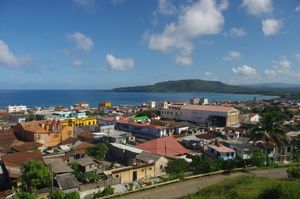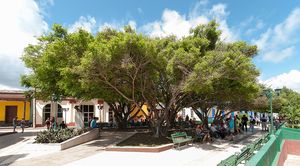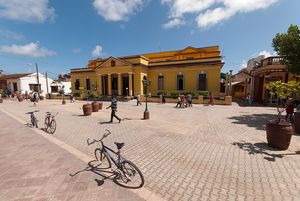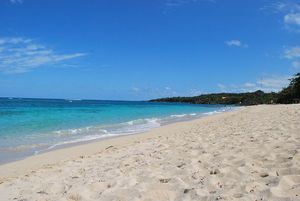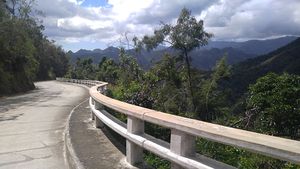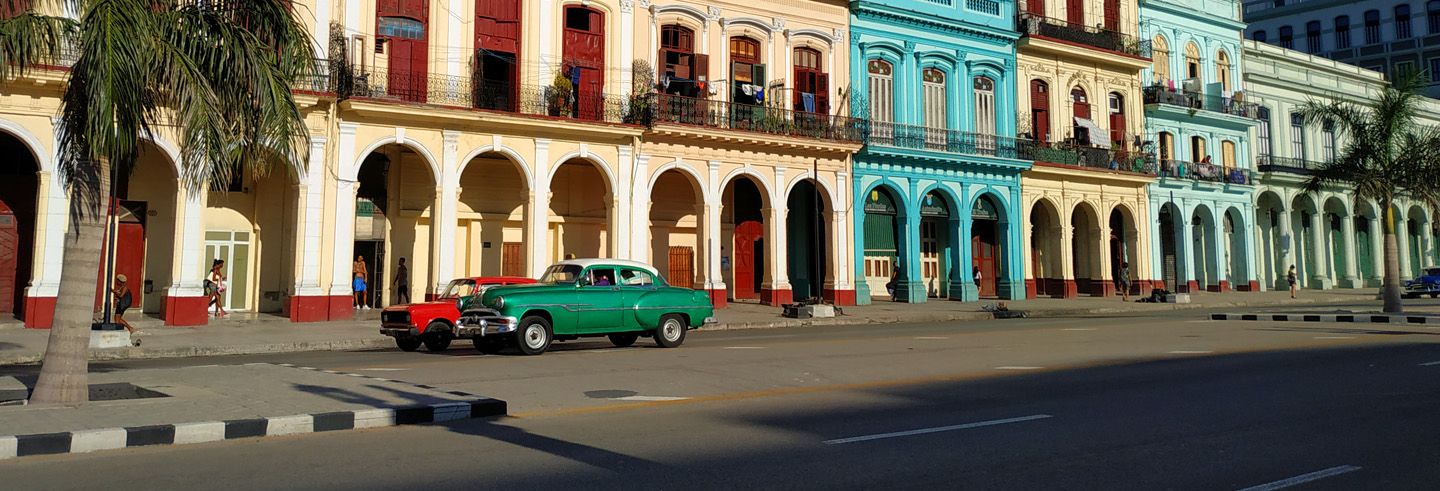

Baracoa, Cuba
Explore Baracoa, the First City of Cuba, surrounded by beautiful natural and colonial treasures or its historic fortresses
Baracoa, National Monument of Cuba, is the oldest colonial city on the island, which is why it is known as the First City. All its charm is located at the eastern end of the island, in the province of Guantánamo.
This Cuban jewel is hidden among mountain ranges with abundant and beautiful endemic vegetation, which also has crystalline rivers and paradisiacal beaches. Without a doubt, it is a unique exotic place in the whole island; as evidenced by the highly preserved treasure Parque Nacional Alejandro de Humboldt (Alejandro de Humboldt National Park).
The Spanish, seeing the beauty of Baracoa, decided that it would become their first town (founded by Diego Velázquez in 1511), under the name of "Our Lady of the Assumption of Baracoa."
The wealth of these lands subjected Baracoa to constant confrontation between the native inhabitants and the Spanish for centuries, giving rise to very interesting legends such as the one that relates the death of Chief Hatuey.
Its narrow, cobbled streets are steeped in history, surrounded by old mansions that stretch from Fuerte la Punta (Fort La Punta) to the Fortaleza de Matachin (Matachín Fortress), two of its most important attractions next to the Castillo de Seboruco (Seboruco Castle).
Walk around the first Spanish village, where you will find ancient fortresses, incredible beaches, unique mountains and one of the most important Cuban national parks. Baracoa is a city that you should not miss on your way through the province of Guantánamo.
Index:
- What to see in Baracoa, Cuba?
- Trips to take in Baracoa
- Where to stay in Baracoa?
- How to get to Baracoa, Cuba?
- When to visit Baracoa?
What to see in Baracoa, Cuba?
The First City of Cuba has a long history and several cultural and natural attractions, hence it has been named a National Monument. Within its colorful streets, in the Historic Center of the City, you will find Parque Independencia (Independence Park), previously called Plaza de Armas (Main Square), it is the most prominent public space in the city. In it, the magnificent Parroquia de Nuestra Señora de la Asunción (Parish of Nuestra Señora de la Asunción) stands out, the first parish church on the island and the place where the famous Cruz de la Parra is located, between its stone walls.
Adjoining the busy park is the Casa de La Trova Victorino Rodríguez (House of La Trova Victorino Rodriguez), an important institution that seeks to preserve and promote musical groups with typical styles of the region. Across the street is the Galería de Arte Eliseo Osorio (Eliseo Osorio Art Gallery), an important cultural venue that, in addition to displaying wonderful local works of art, encourages artistic education.
Nearby is the Casa de la Cultura (House of Culture), a place where different events are organized to promote the ancestral artistic traditions of the people of Baracoa. In the same area is the Ayuntamiento de Baracoa (Baracoa City Hall), a towering colonial building renovated with a striking yellow color.
One of the main characteristics of Baracoa is that three fortresses were built for the protection of the city. Currently all of them fulfill a different function, but in the same way they allow you to enjoy what were the military buildings.
The Fuerte Matachín (Matachín Fort) today is the Museo Municipal (Municipal Museum), where aboriginal archaeological collections and articles representing the history of the city are preserved. Today, Fuerte la Punta is a restaurant, so in addition to touring its walls, you can enjoy exquisite typical Cuban food. Likewise, the Castillo de Seboruco (Seboruco Castle) has been transformed and is today the Hotel el Castillo, a renowned hotel that has adapted the facilities for tourists to enjoy the city while staying in a true archaic castle.
In the outskirts of the city you will find the Ranchón del Nengón and Kiribá, a lively hacienda where the preservation of the ancestral predecessor rhythms of the Cuban son is celebrated. You will also find the Museo arqueológico de Baracoa (Baracoa Archaeological Museum), a unique museum inside a cave, where you can see first hand the remains of the Taino culture.
Trips to take in Baracoa
Baracoa is surrounded by a unique natural wealth in which rivers, beaches, parks and nature reserves come together to create spectacular landscapes worthy of admiration. Among the activities to do there are several excursions to different natural areas.
One of the most important is the Reserva de la Biosfera Cuchillas del Toa (Cuchillas del Toa Biosphere Reserve), one of the centers of greatest endemism and biodiversity in Cuba and the Insular Caribbean. Its name comes from the Rio Toa (Toa River), the river with the highest flow on the island, and its main attraction is the Parque Nacional Alejandro de Humboldt (Alejandro de Humboldt National Park), declared a World Heritage Site.
This National Park, called "the natural jewel of Cuba", presents different activities to enjoy its fascinating fauna and flora.There are tours to spot beautiful endemic animals and you may even be lucky enough to see some endangered species. Likewise, there are routes to observe the species of wild flora typical of Cuba, in which you will enjoy observing different types of native plants such as the Coconut Palm, the Royal Palm and the mangroves. Also, if you prefer, you can take an adventurous tour along the Jiguaní river to the beautiful La Fundadora beach.
Within the reserve there is also Parque El Yunque (El Yunque Park) that, in addition to housing the symbol of the city and National Monument (the unique rock formation shaped like an anvil), offers different routes to enjoy different rivers and the fertility of its lands with abundant fruit trees. The Outstanding Natural Element presents trails to climb the Yunque and enjoy spectacular views of the bay. You can take a tour of the Duaba river and its crystal clear waters, or the Toa river and its mighty currents.
One of the main attractions of the region are the cultivation of fruit plants such as coconut, cocoa, banana and coffee. You will be able to learn about the artisanal elaboration of different coconut products and at Finca Duaba (Duaba Farm) you will learn the process involved in making chocolate, from its plantation to its production, on the well-known cocoa trail.
Beyond these places, you will find the Parque Majayara (Majayara Park) where, in addition to a delightful nature, you will also find beautiful marine terraces, some of them with fascinating caves that preserve ancient remains of the Taino communities that inhabited the area. It is an ideal place to do speleology and discover the interesting La Perla de Agua cave or the Cangrejo cave, which have more than 500 cave paintings and some water channels. It is an area that presents a true treasure of the aborigines who inhabited the area hundreds of years ago.
On the way to Boca de Yurumí, you will pass through the Paso los Alemanes, an impressive natural tunnel created by the tectonic movement in the region. Its splendor has given it the title of Outstanding Natural Element, as has the Parque Yumurí (Yumurí Park). In this movie-like landscape, where the Yumurí River empties, you can take a raft ride, enjoy the beaches and the exotic landscape adorned with dense vegetation.
Although Baracoa is close to nature, it also has a large number of beautiful beaches where you can enjoy a well-deserved rest, the vast majority of them with clear waters, shallow shores and white sands.
Among the most popular are Miel and Manglito beaches, whose proximity and beauty make them a popular place among bathers. Those that are ideal for relaxation, with crystal clear and calm waters are the Nava, Mapurisí, Cajuajo and La Fundadora beaches. The one with black sand is the spectacular Duaba beach, which also hosts the Monumento Nacional Desembarco del Duaba (Desembarco del Duaba National Monument). Finally, those with white sands with refreshing crystalline waters are Blanca and Maguana beaches, which are also often visited by bathers.
On your tour of Baracoa, you will pass through the Viaducto de la Farola (La Farola Viaduct). It is a true work of Cuban engineering that sought to connect the region that for a long time was isolated from the rest of the island and that, in turn, managed to respect the natural environment.
Where to stay in Baracoa
In Baracoa you will find, as in many other cities in Cuba, the wonderful opportunity to stay in private homes. This unique experience will take you into culture and will allow you to enjoy this wonderful city in a unique way. The warm welcome of the people of Baracoa, and the fabulous tips and recommendations will allow you to discover the place with a truly local context.
If you are looking for other types of accommodation, you can find the Plaza Hotel, a pleasant hotel in the historic center of the city that has been restored for greater comfort; the Baracoa Hotel, a pleasant hotel with a fantastic view of the sea that was recently renovated; the famous El Castillo Hotel, former Castillo de Seboruco (Castle of Seboruco), is a splendid hotel with an enchanting view of the bay and a refreshing swimming pool; and the Porto Santo Hotel, a privileged place ideal for relaxation and built on a hill facing the sea.
Within a tighter budget and with a more central location, you can find the Río Miel Hostel, a cozy hostel with a great view of the sea; Hostel 1511, a beautiful colonial house adapted into a comfortable hostel; the La Rusa Hostel, a pleasant hostel with delightful views of the sea; and the La Habanera Hostel, a fabulous inn located next to the Centro Histórico de Baracoa (Historic Center of Baracoa) and a few meters from the boardwalk.
If you visit Baracoa for its nature and are looking to discover it more, you can enjoy some ecological lodges such as Campismo El Yunque (El Yunque Camping), a pleasant campsite located right next to the Duaba River in the heart of the wonderful Parque Natural el Yunque (El Yunque Natural Park). Finca La Esperanza (La Esperanza Farm) is the ideal place to connect with nature, since the accommodation is much more traditional in order to enjoy the natural environment. Lastly, Campismo Duaba is a colorful campsite where you will be able to cool off in the nearby Duaba River and by the Baracoa waterfall.
How to get to Baracoa, Cuba
If you decide to arrive by air you have several options. The first one is to get directly to the Baracoa National Airport, in just 2 and a half hours from Havana. The other option is to get to the Guantanamo National Airport and from there, select a ground transportation that will take you to Baracoa in two hours. From the Santiago de Cuba International Airport you will still have to travel 4 hours by road, although it may be your point of arrival in Cuba.
Finally, there is also the option of arriving by sea from international waters to the Bay of Baracoa.
If you are already in the Cuban East, you have different options, mainly by road, using collective or private transfers, although it is advisable to always hire them before your arrival in Cuba.
When to visit Baracoa
Baracoa is a city that is worth visiting at any time, but if you are passionate about Cuban culture and party, you can visit during Baracoa Culture Week, which takes place during the last week of March, and where different activities and shows showing the most wonderful traditions of dance and art.
Likewise, if you like parties and food, you cannot miss the Carnavales Baracoenses (Baracoan Carnivals) during the beginning of April. The lively celebration, open to the whole family, is enjoyed in the streets to the beat of the conga parades and the different folkloric rhythms of the region. The joy of the people is complemented by delicious street stalls with typical food.
Finally, one of the most important cultural events in Baracoa is the Fiesta de las Aguas, held from August 10 to 15. The anniversary of the founding of the first Spanish town is celebrated, in which the city is enriched in the search to share and preserve its traditions and history. Several commemorative events are held for important historical figures.
Interactive map:
Guantánamo
What to see:
- City of Guantánamo
- Martí Park
- Plaza del Mercado Market Square
- Policarpo Pineda Rustán Library
- Plaza Mariana Grajales Square
- Punta de Maisí
- Boca de Yumurí
- Baracoa
- Catedral de Nuestra Señora de la Asunción
- Seboruco de Santa Bárbara Castle
- El Yunque
- Alejandro de Humboldt National Park
- Río Toa
- La Farola Viaduct
- Zoológico de Piedras
Beaches:
Museums:
Other nearby destinations:
Why "Trip Cuba"?
Trip Cuba is an organization of Cuban agencies whose objectives are:
- ✓ To make Cuba, its culture and its heritage known.
- ✓ To promote sustainable tourism.
- ✓ To support the local economy, prioritizing direct contact with Cuban agencies.
Travel Agencies
If you are a travel agency or tour operator and you are looking forward to any assistance or collaboration to plan trips to Cuba, rely on our extensive experience
Copyright www.TripCuba.Org © - All rights reserved
All our agencies are duly registered in the National Registry of Travel Agencies of the Chamber of Commerce of the Republic of Cuba.







